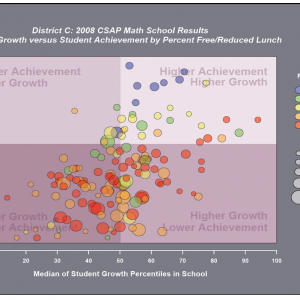
Last week Education Next published an article entitled “Choosing the Right Growth Measure” that compares three types of growth models and claims that the “best” model is a two-step value-added model (VAM) that fully controls for student characteristics (e.g., race, gender, free or reduced-price lunch eligibility, English-language-learner status, special education status). The authors claim that this approach provides the most useful information to educators and local decision makers. I was immediately struck by a headline in a press release on the article which proclaimed “Measuring student performance correctly helps set the right expectations for students and teachers in both high-poverty and advantaged schools.” This enraged me.
Is this article telling me that the “right” expectations for disadvantaged students should be lower than the expectations for advantaged students? That “measuring performance correctly” means telling teachers in disadvantaged schools that their students will never grow as much as students in advantaged schools, so they shouldn’t worry about helping their students catch up? This is what people refer to as the “soft bigotry of low expectations.” I believe that all students can and must learn at a high level, regardless of their circumstances.
Poverty and other disadvantages are real factors that do impact students’ performance. We can’t ignore that. Poverty makes things harder, but we shouldn’t say that it makes things impossible by setting a lower bar for disadvantaged schools. It’s like saying, “You’re attractive…for your age” or “You’re smart…for a girl” or, literally, “You’ve learned a lot…for a poor kid.” How about instead of lowering expectations for students who are at a disadvantage, we maintain high expectations and work that much harder to make up for those disadvantages? It’s not easy, but we’ve seen disadvantaged schools whose students are successful regardless of how they compare to others. We should create opportunities to replicate these schools. And we should hold them up as examples to remind ourselves that students and teachers can rise to the challenge if we maintain high expectations for everyone.
While I object to the idea that the two-step VAM described in the Education Next article is the single “best choice,” I do think that this model could be useful as one of many measures in a comprehensive accountability system. The two-step VAM model alone won’t tell you if a school or teacher is doing a great job of getting students to proficiency; but schools and teachers that perform poorly on this measure can no longer dodge closures or firings by using the all-too-often-accepted excuse that the disadvantages of their students are the reasons for low performance.
Authorizers do need to be able to identify and close the very worst schools, and the two-step VAM will help them do that. But authorizers also need to set expectations for what a quality school looks like and evaluate whether schools are adequately preparing students for future success. In order to do that, they need to look at additional measures like proficiency, college and career readiness, and even additional types of growth models, such as student growth percentiles and growth-to-proficiency models. We have to be careful not to pretend that there’s any one perfect measure of school or teacher performance, or that looking at a “fair” comparison of schools serving similar students as a stand-alone measure doesn’t lower our expectations for what disadvantaged students can achieve. We need to look at academic achievement from multiple angles. And more than anything, we need to believe that all students can and must learn and reflect that in our accountability systems.


